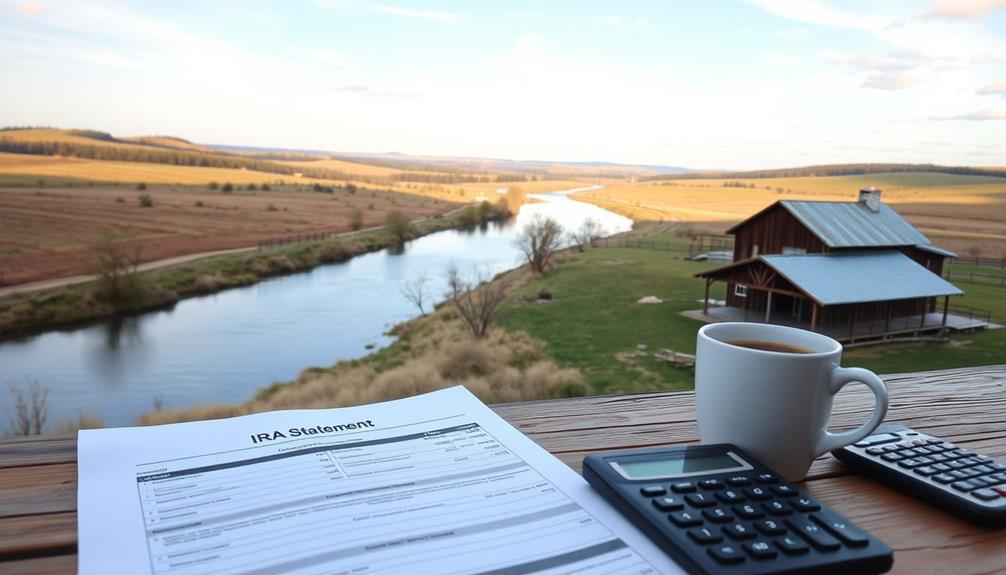Sequence-of-returns risk means that a bad year early in your retirement can drastically reduce your savings, making it hard to maintain your lifestyle. The timing of market downturns matters more than overall returns, and one poor year can force you to withdraw at a loss, depleting your nest egg faster. By understanding this risk, you can learn strategies to protect your savings even during tough markets. Keep exploring to find ways to shield yourself from this hidden danger.
Key Takeaways
- One bad year early in retirement can significantly deplete savings due to poor market returns during withdrawals.
- Sequence-of-returns risk emphasizes the importance of flexible withdrawal strategies to adapt to market fluctuations.
- Diversifying investments reduces volatility and mitigates the impact of poor market years on overall savings.
- Building an emergency fund provides a financial cushion, preventing forced sales during downturns.
- Proper planning and risk management can help preserve decades of savings despite negative market sequences.

Sequence-of-returns risk refers to the possibility that the order of investment returns can markedly impact your retirement savings, especially during withdrawal periods. Even if your investments earn a solid average return over time, a bad year early in retirement can considerably diminish your nest egg. This risk is especially tricky because it’s not about the total return you earn but when those returns occur. A poor sequence of returns can force you to sell shares at a loss, depleting your savings faster than expected and potentially jeopardizing your financial security.
Sequence-of-returns risk can deplete your savings faster if early losses force costly sales.
To mitigate this risk, you need to be strategic about how and when you withdraw your funds. One effective approach is practicing market timing, although it’s notoriously difficult to predict short-term market movements accurately. Instead of trying to time the market precisely, focus on maintaining a flexible withdrawal strategy that can adapt to market conditions. For instance, you might withdraw less during downturns and more during periods of growth, helping to preserve your capital during tough times. This approach minimizes the chance that a poor market sequence in the early years of retirement will erode your savings too quickly.
Another key strategy is portfolio diversification. By spreading your investments across different asset classes—such as stocks, bonds, and cash—you can reduce the volatility that comes with concentrated holdings. Diversification helps smooth out the bumps in your investment journey, so a bad year in the stock market doesn’t wipe out your entire portfolio. During market downturns, a diversified portfolio can provide steadier income streams, giving you peace of mind and reducing the need to sell investments at a loss to cover expenses.
It’s also essential to build a buffer, like an emergency fund, to cover unexpected expenses or market dips. This way, you won’t be forced to sell investments during a downturn just to meet immediate cash needs. Having a safety net allows your investments more time to recover from bad years, which is critical because the sequence of returns in the early phase of retirement can have lasting impacts.
Ultimately, managing sequence-of-returns risk requires a combination of strategic planning and disciplined investment management. While you can’t control market fluctuations, you can control your response. By practicing prudent market timing, maintaining a diversified portfolio, and building buffers, you give yourself a better chance of safeguarding your retirement savings against the unpredictable twists and turns of market sequences.
Frequently Asked Questions
Can Sequence-Of-Returns Risk Be Completely Avoided?
You can’t completely avoid sequence-of-returns risk, but you can manage it. Diversifying your investments helps smooth out market volatility, reducing your chances of major losses during downturns. Additionally, careful withdrawal timing—like delaying withdrawals during market dips—can protect your savings. While no strategy guarantees elimination, combining diversification with smart withdrawal planning greatly lowers your risk of one bad year ruining decades of savings.
How Does Sequence-Of-Returns Risk Differ From Market Risk?
You might think market risk is just about overall volatility, but sequence-of-returns risk is different. It relates to your investment timing—getting bad returns early can severely impact your savings, even if the market recovers later. While market risk affects your entire portfolio over time, sequence-of-returns risk focuses on how the order of those returns influences your retirement, making timing vital in managing your investment outcomes.
What Strategies Best Mitigate Sequence-Of-Returns Risk?
To best mitigate sequence-of-returns risk, you should diversify your investments across asset classes to reduce potential losses. Additionally, timing your withdrawals carefully—such as delaying them during downturns—can help preserve your savings. Regularly reviewing your portfolio and adjusting your withdrawal strategy based on market conditions also protects you from a single bad year derailing your long-term financial goals.
Does Sequence-Of-Returns Risk Affect All Types of Retirement Accounts?
Think of your retirement savings like a garden; different account types and investment vehicles are the seeds. Sequence-of-returns risk can impact all of them, whether it’s a Roth IRA, 401(k), or taxable account. The risk isn’t limited to specific investment vehicles; it’s about market fluctuations affecting your entire portfolio. So, yes, all account types are vulnerable, making it essential to diversify and plan wisely.
How Can Retirees Plan for Sequence-Of-Returns Risk Today?
You can plan for sequence-of-returns risk today by adopting smart withdrawal strategies, such as the “bucket” approach or adjusting withdrawals based on market performance. Diversification techniques also help protect your savings, spreading investments across asset classes to reduce volatility. Regularly reviewing your plan and staying flexible allows you to adapt during market downturns, minimizing the impact of bad years on your long-term retirement income.
Conclusion
Think of your retirement journey as steering a boat through unpredictable waters. One stormy year can shake your vessel, threatening to capsize decades of careful sailing. But with steady navigation—diversified investments and flexible plans—you can weather the storms. Remember, it’s not just about avoiding rough seas, but knowing how to steer through them. Stay vigilant, adapt, and keep your eyes on the horizon—your peaceful retirement destination.









